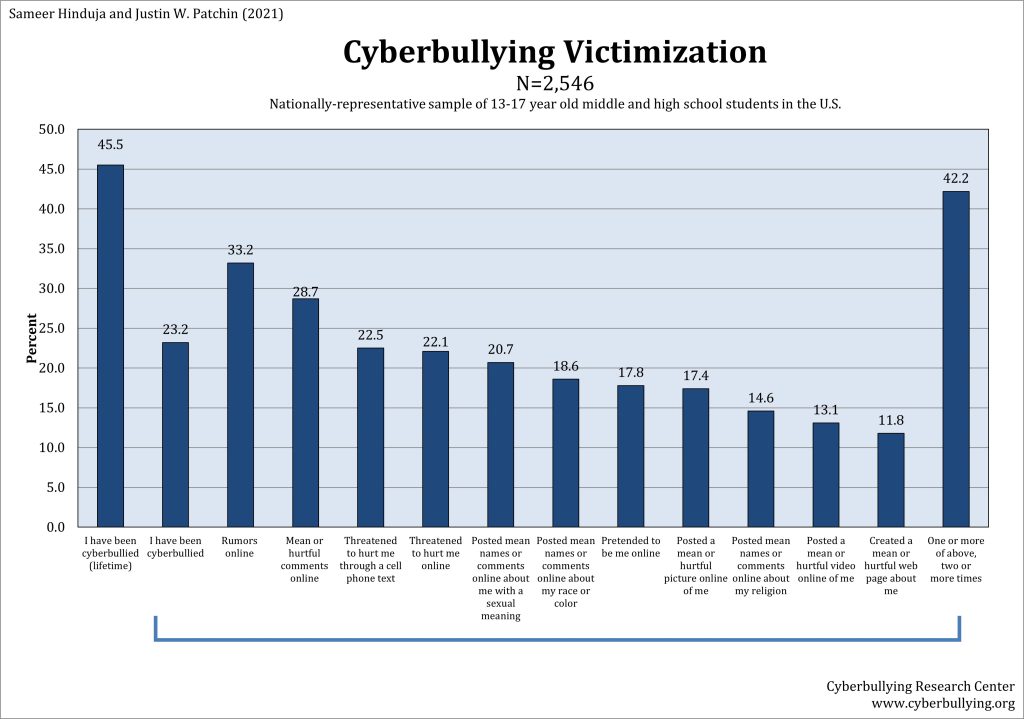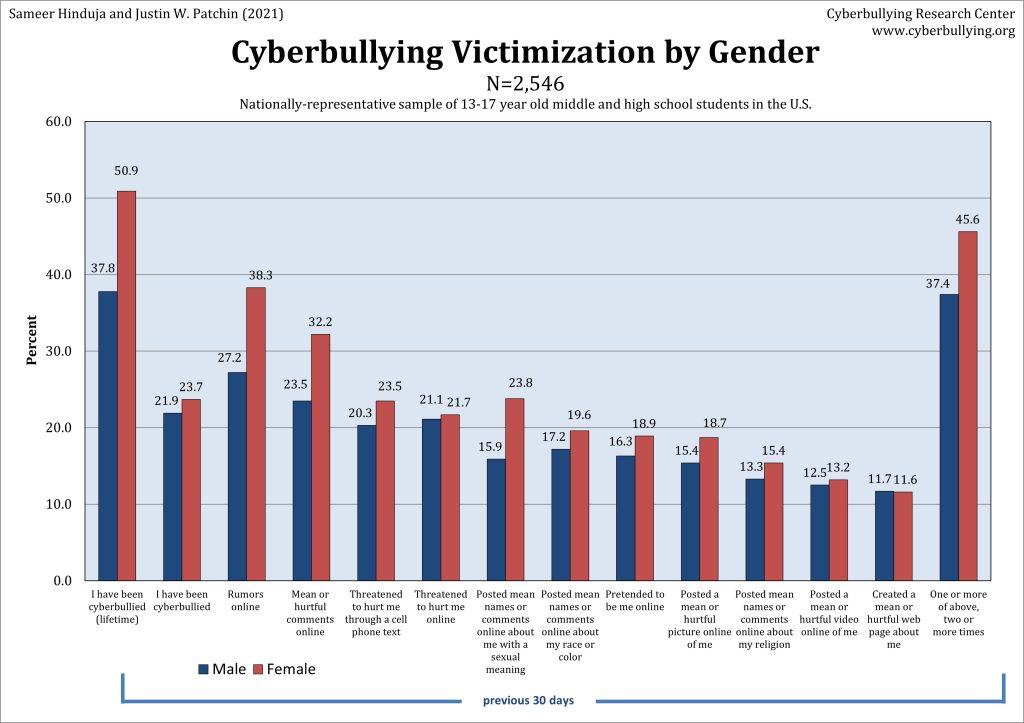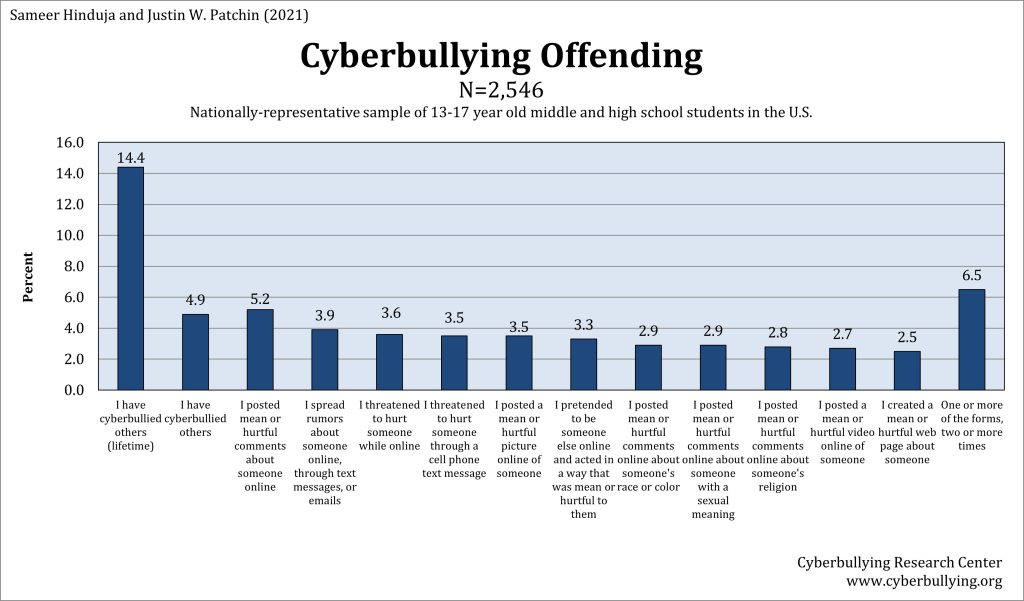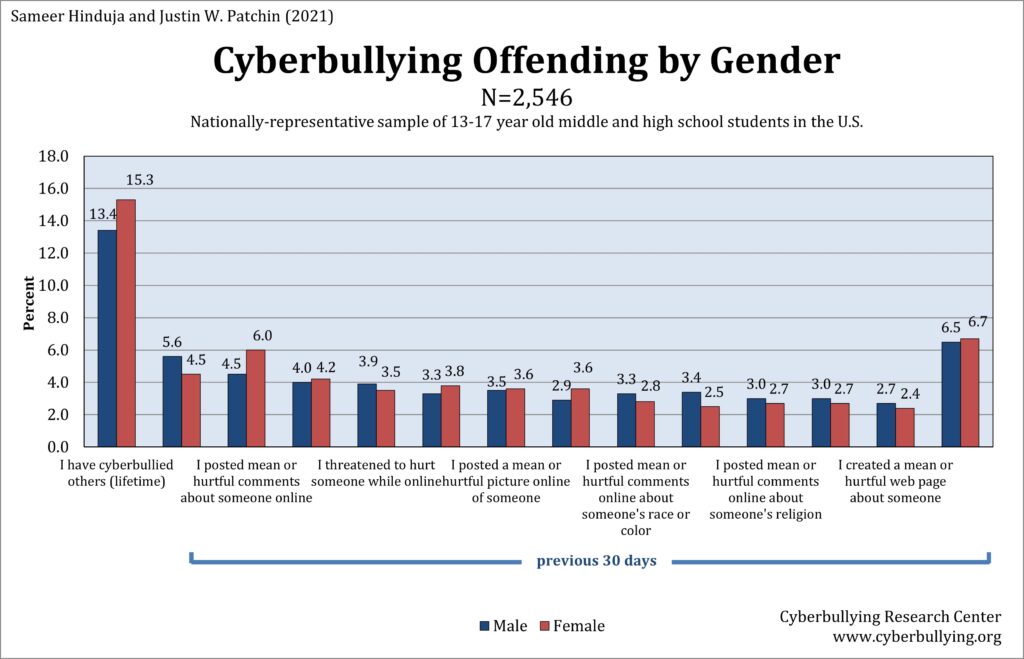
This study surveyed a nationally-representative sample of 2,546 middle and high school students between the ages of 13 and 17 in the United States. Data were collected in April and May of 2021. Click on the thumbnail images to enlarge.




Cyberbullying Victimization. We define cyberbullying as: “Cyberbullying is when someone repeatedly and intentionally harasses, mistreats, or makes fun of another person online or while using cell phones or other electronic devices.” Approximately 46% of the students in our 2021 sample report experiencing cyberbullying in their lifetimes. When asked about specific types of cyberbullying experienced in the previous 30 days, rumors spread online (33.2%) and mean or hurtful comments (28.7%) continue to be among the most commonly-reported. Forty-two percent of the sample reported being cyberbullied in one or more of the twelve specific types reported, two or more times over the course of the previous 30 days.
Cyberbullying Offending. Approximately 14% of the students in our 2021 sample admitted to cyberbullying others at some point in their lifetime. Posting mean comments online was the most commonly reported type of cyberbullying they reported during the previous 30 days (5.2%). About 6.5% of the sample reported cyberbullying using one or more of the eleven types reported, two or more times over the course of the previous 30 days. These numbers are lower than what we observed in 2019 and 2016.
Cyberbullying by Gender. Adolescent girls are more likely to have experienced cyberbullying in their lifetimes (50.9% vs. 37.8%). This difference is not as dramatic when reviewing experiences over the previous 30 days, where rates are very similar (21.9% of boys and 23.7% of girls have been cyberbullied recently). In this sample, girls were more likely to report cyberbullying others during their lifetime (15.3% vs. 13.4%) though boys reported more recent offending behaviors (5.6% vs. 4.5%).
Methodology
For this study, we contracted with an online survey research firm to distribute our questionnaire to a nationally-representative sample of middle and high school students who were between the ages of 13 and 17. Students were asked questions about experiences with bullying and cyberbullying, digital self-harm and other experiences online and off. Overall we obtained a 15% response rate, which isn’t ideal, but is higher than most generic Internet surveys.
With any imperfect social science study, caution should be used when interpreting the results. We can be reassured somewhat in the validity in the data, however, because the prevalence rates are in line with results from our previous school-based surveys. Moreover, the large sample size helps to diminish the potential negative effects of outliers. Finally, steps were taken to ensure valid responses within the survey instrument. For example, we asked the respondents to select a specific color among a list of choices and required them to report their age at two different points in the survey, in an effort to guard against computerized responses and thoughtless clicking through the survey.
Suggested citation: Patchin, J. W. & Hinduja, S. (2022). 2021 Cyberbullying Data. Cyberbullying Research Center. https://cyberbullying.org/2021-cyberbullying-data
Select publications from this data set:
Hinduja, S. & Patchin, J. W. (2024). Bullying Beyond the Schoolyard: Preventing and Responding to Cyberbullying (3rd Ed.). Thousand Oaks, CA: Sage Publications (ISBN: 978-1071916568).
Patchin, J. W. & Hinduja, S. (2024). Adolescent digital self-harm over time: Prevalence and perspectives. Journal of School Violence, 1–13. https://doi.org/10.1080/15388220.2024.2349566
Patchin, J. W. & Hinduja, S. (2023). Cyberbullying Among Asian American Youth Before and During the COVID-19 Pandemic. Journal of School Health, 93, 82-87.
Blog posts based on this data set:
May 13, 2024 – Digital Self-Harm: The Growing Problem You’ve Never Heard Of
October 4, 2023 – Cyberbullying Continues to Rise among Youth in the United States
October 14, 2022 – Cyberbullying Among Asian American Youth Before and During the COVID-19 Pandemic
September 29, 2021 – Bullying During the COVID-19 Pandemic







